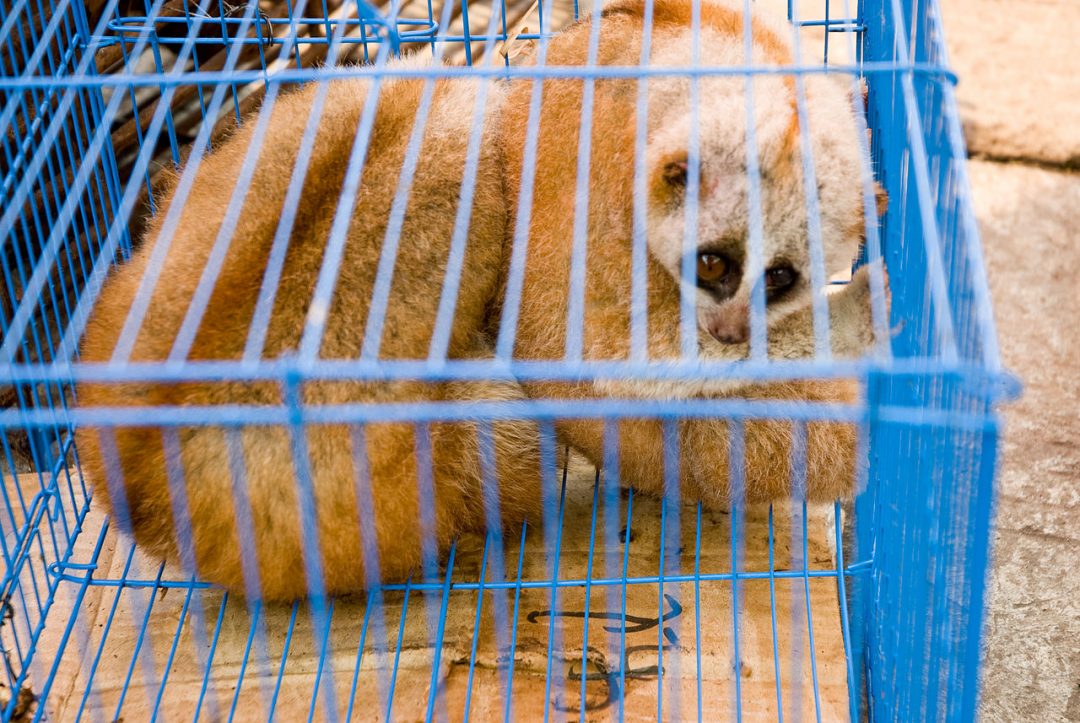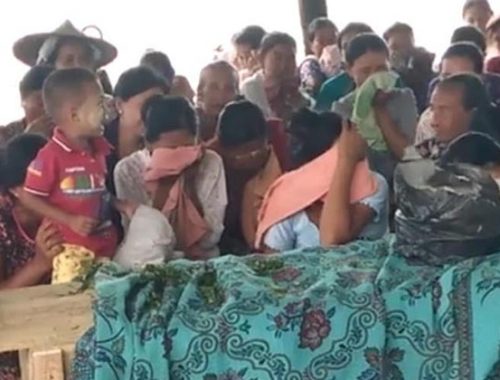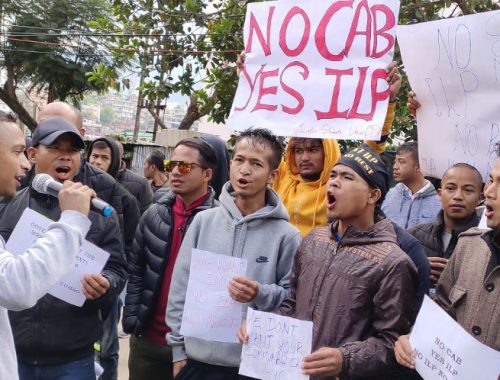Emily Fishbein–
PUTA-O, Myanmar — In late 2018, following a series of demonstrations and confrontations, indigenous communities primarily from the Rawang ethnic minority expelled the Myanmar Forest Department and its international partner, the Wildlife Conservation Society (WCS), from an area known as the Hkakaborazi Landscape, amid mounting dissent over a potential UNESCO World Heritage nomination.
The 11,280–square-kilometer (4,355-square-mile) area, located in Myanmar’s northernmost Puta-O region, encompasses roughly 4,000 people who depend on hunting, foraging and shifting cultivation.
The expulsion of the Forest Department and WCS came following years of mounting grievances. The communities say that Forest Department management, under a WCS-supported national park designation, resulted in a breakdown of customary practices passed down generationally, and opened up a resource grab, while destroying local livelihoods.
World Heritage plans are suspended indefinitely, and communities continue to bar outsiders from entering, maintaining they are best-placed to conserve the forest themselves.
In interviews for Mongabay with two Rawang villagers, two Rawang community workers, two Kachin civil society groups, one local researcher, and representatives from WCS and the Forest Department, there was a common theme that Rawang communities in Hkakaborazi had built up a growing mistrust of WCS and the Forest Department. This mistrust appears to have contributed to strong resistance to a World Heritage nomination.
View from above of Ta Su Htu village in Hkakaborazi, Myanmar. Image by Sanlu Ram Seng. Myanmar, undated.
View from above of Ta Su Htu village in Hkakaborazi, Myanmar. Image by Sanlu Ram Seng. Myanmar, undated.
Chief among local grievances are feelings of neglect, loss of livelihood, and a breakdown of customary practices accompanied by environmental destruction since Hkakaborazi came under Forest Department management as a national park in 1998.
WCS was the first international conservation group to initiate long-term programming in Myanmar, where it has partnered with the Forest Department since 1993, when the country was under military rule. Prior to Hkakaborazi, WCS garnered local criticism for its close collaboration with the central government in relation to Kachin state’s Hukaung Valley, where, in 2004, WCS’s director of science and exploration, Alan Rabinowitz, supported the Forest Department to establish a 6,300–km2 (2,430-mi2) wildlife sanctuary.
Two years later, 810 km2 (312 mi2) of the sanctuary was conceded for biofuel production to a company with close ties to the military, and in 2008, a Russian energy company was granted oil exploration rights to parts of the sanctuary. Nonetheless, in 2010, Rabinowitz and WCS supported the Forest Department to expand the park’s boundaries by a further 11,000 km2 (4,250 mi2). At the time, despite documented local reports of forced relocation and environmental destruction, WCS’s Asia director, Colin Poole, said the expansion marked “a cornerstone of tiger conservation.” By 2014, less than 50 tigers remained.
Rabinowitz, who passed away in 2018, made his first expedition to Hkakaborazi in 1996. Two years later, the 3,810-kms (1,470-mi2) Hkakaborazi National Park was established, and in 2003, neighboring Hponkanrazi Wildlife Sanctuary, at 2,700 km2 (1,040 mi2).
Villages inside the conservation area lack basic infrastructure, while government schools end at fourth grade and villagers must walk days to access health care or buy basic items such as rice, oil and salt.
A community worker who requested anonymity told Mongabay that in the park’s early years, WCS would support small infrastructure projects and donate rice and basic supplies to villagers.
The Forest Department’s U Thein Aung, who established Hkakaborazi National Park and served as its warden from 1999 to 2007, said that he and WCS’s education team regularly visited villages to explain about the park regulations, and up until his transfer, faced “no problem” with communities.
Yet at some point, this relationship soured, with widespread allegations that WCS and the Forest Department had promised educational, food, infrastructure and financial assistance which was never delivered.
“When the organizations came in, they promised to fix our difficulties, but they didn’t,” said Sanlu Ram Seng, a climbing guide from a village inside Hkakaborazi National Park. “They neglected us.”
Similar grievances were also portrayed in the locally produced 2019 documentary Tears Beyond the Icy Mountain.
WCS declined to comment to Mongabay on this issue, while U Thein Aung of the Forest Department told Mongabay, “I did not promise local people [anything], because I had no chance to give funding, I can only share techniques.”
Communities also say that park regulations – which banned commercial hunting, logging, and the commercial trade of wildlife, wild plants and other forest products, as well as hillside cultivation – restricted their livelihoods.
Morning market in Puta-O, Myanmar. Image by Hkaw Myaw. Myanmar, 2020.
Morning market in Puta-O, Myanmar. Image by Hkaw Myaw. Myanmar, 2020.
“People had been searching for forest items and animals for their survival, only taking what they needed. Suddenly, they had to report all their actions and face interrogation. They were living in fear,” said Phong Phong, a youth from a village inside Hponkanrazi Wildlife Sanctuary.
Restrictions on planting non-native seeds also cut them off from growing the cardamom and walnut trees upon which many depended, he said.
“It’s not that we don’t accept environmental conservation,” Phong Phong said. “The reason we willingly agreed [to a protected area designation] is because the government said they would support and protect it. The truth is, our precious ecosystem is being destroyed. The way they managed it was not successful … They just said, ‘Don’t do this. Don’t do that.’ We have been conserving [the forest] and depending on it for our survival but now it’s almost gone.”
U Thein Aung said he was aware of local mistrust of Forest Department management and restrictions. “The Rawang understand the Puta-O region including Hkakaborazi is their land, and they want to manage it. They do not like management by the central government,” he said.
Yet a dissonance appeared in perceptions of local conservation awareness.
“Rawang people want to manage Hkakaborazi themselves, but they do not understand how to conserve or manage it,” U Thein Aung said. “They do not understand the importance of biodiversity and its sustainable use.”
In contrast, ethnic Rawang interviewed by Mongabay asserted that they understood this importance most, having lived sustainably in the forest for generations.
Ram Seng said that before Hkakaborazi became a government protected area, “Families valued the living things in the streams. They cut the trees when the time came. When they went hunting they only caught male animals, and released the females … They acknowledged each family’s territory, and didn’t touch or destroy another family’s things. That’s why it is still one of the most beautiful places and has many rare species. Communities cared for the environment with so much love.”
Dried meat and honey at the morning market in Puta-O, Myanmar. Image by Hkaw Myaw. Myanmar, undated.
Dried meat and honey at the morning market in Puta-O, Myanmar. Image by Hkaw Myaw. Myanmar, undated.
He said this sentiment was lost when the area came under Forest Department management. “The Forest Department said, ‘It doesn’t relate to your community anymore. We took responsibility over this area … although this stream used to belong to me, I don’t own it anymore, so I will destroy it,’” became the mentality, Ram Seng told Mongabay. “The environment was destroyed. The community got angry and blamed [the Forest Department] for that.”
Hpong Ri Minn, who from 1999 to 2016 served on the Rawang Literature and Culture Association, a leading actor in opposing the World Heritage nomination, said that under Forest Department management, communities felt like “This place doesn’t belong to you anymore. It belongs to the government.”
“Since they couldn’t manage it, it became, ‘If I can cut, I will cut. If I can take out, I will take out.’ Not only outsiders but also the villagers took out forest items randomly, and the trees and wildlife decreased. The community didn’t have an ownership mindset anymore,” he said.
When environmental destruction followed, communities came to doubt the effectiveness of being a national conservation area, he said. “The community said all the medicinal herbs and wildlife was taken during 20 years of conservation [as a protected area]. Nothing was left, so the community questioned what environmental conservation referred to … There are many restrictions though nothing is being conserved well,” he told Mongabay.
Contested boundaries
In 2013, UNESCO commissioned a scoping study to identify sites in Myanmar with a potential for natural World Heritage nomination. To increase the elevation range and biodiversity of the Hkakaborazi and Hponkanrazi protected areas, and hence strengthen claims to outstanding universal value according to UNESCO’s 1972 convention, a 4,778–km2 (1,845-mi2) “southern extension” was added to the proposed nomination area.
The Ministry of Environmental Conservation and Forestry (MOECAF), which includes the Forest Department, submitted intent to nominate this area, which it called the Hkakaborazi Landscape, in late 2014. In 2015, UNESCO subcontracted WCS to support the ministry with some aspects of the nomination process.
The area includes tropical evergreen, mixed deciduous, and pine-rhododendron forest, snowcapped mountains and alpine meadows, and an estimated 6,000 plant and 750 animal species. Hkakaborazi and Hponkanrazi mountains, among Southeast Asia’s tallest, serve as the watershed for the N’Mai and Mali rivers, which join to form Myanmar’s largest river, the Irrawaddy.
Roughly 4,000 people live within the area, including 1,900 in Hkakaborazi National Park, 2,000 in Hponkanrazi Wildlife Sanctuary, and 170 in the southern extension.
The tentative listing of the Hkakaborazi Landscape on the UNESCO website lists logging and mining as threats to the area, as well as infrastructure development plans around the town of Puta-O which “could result in in-migration and increased human impacts.” The listing also mentions commercial wildlife hunting and the gathering of non-timber forest products within the park’s boundaries as environmental threats.
In late 2016, UNESCO conducted a series of visits to northern Kachin to introduce the concept of World Heritage and its potential implications, while the Forest Department and WCS began sharing information about World Heritage in villages.
Those interviewed by Mongabay say that initially, communities supported the nomination, but problems arose over the southern extension, where villagers strongly opposed coming under Forest Department management.
“The Forest Department should have negotiated with villagers before demarcating the boundaries of the southern extension, but they didn’t,” said Min Seng of Nam Shani Social Development Organization, which supported mediation efforts between communities, the Forest Department and WCS.
‘They kick out anyone who comes’
Local media reported that the Rawang Literature and Culture Association submitted letters to the government in March and May of 2017, asking that plans for the southern extension be dropped, but said it received no reply. On July 28, the natural resources and environment ministry announced plans to proceed with the nomination, according to local media.
Tensions escalated and on Sept. 28, 2017, led by the Rawang Literature and Culture Association, thousands demonstrated across four towns, calling for the withdrawal of WCS from the area and an end to the World Heritage nomination.
The association’s leader, Marip Yaw Shu, declined Mongabay’s request for an interview.
Min Seng said that over the following year, meetings and public hearings were held to bridge rifts between the groups, but with little progress. Instead, 2018 saw a series of incidents, including communities’ expulsion of a WCS and Forest Department research team from Hponkanrazi Wildlife Sanctuary, the burning of a Forest Department guard post in Hkakaborazi National Park, and further demonstrations.
Communities have blocked outsiders from the national park and wildlife sanctuary area since late 2018. “The villagers said, ‘We won’t accept you anymore as nothing happened as you had promised,’” said Ram Seng. “They kick out anyone who comes.”
The Forest Department evacuated its guard posts inside the parks, and the WCS office in Puta-O remains shuttered.
“Following the community demonstrations, it was clear that consent was not forthcoming and WCS restricted its activities,” said Rob Tizard, who has served as technical adviser to WCS Myanmar since 2006. “We continue to hold an open discussion with local leaders,” he added.
Min Jeong Kim, UNESCO Myanmar Head of Office since early 2017, said she found a silver lining in the fallout over the nomination, in that it helped bring issues into the open. “It was perhaps not what we had hoped for,” she said, “But in the end, with the community coming up and strongly [conveying] how they wanted to manage the site, and how they wanted to have more say in what was going to happen to the place where they live and are actively engaged, I think was a positive outcome.”
“That’s what’s supposed to happen according to UNESCO’s policy on Free Prior Informed Consent and respecting the rights of indigenous people. It was absolutely normal for these issues to be raised, and for the government to respond, for there to be dialogue and a proper process of FPIC going on before any final decision was taken,” she added.
With the UNESCO nomination indefinitely suspended and the Forest Department and WCS expelled more than a year ago, the question remains whether the communities, the Forest Department and conservation groups can find common ground. Mongabay’s interviews with local Rawang revealed a cautious interest in coming together under certain conditions.
Hpong Ri Minn said that in the face of commercial interest, communities may need outside support to protect forest resources. “Forest items have gradually become valuable. In the long term, there will be resource trafficking and the trees will be cut down. [Communities] might be able to control it for the moment, but there will be difficulties the in long term,” he said.
At the same time, he emphasized that conservation efforts must incorporate local inputs and value customary practices. “The Forest Department should welcome the participation of communities and work together with them,” he told Mongabay. “The public welcomes any organization doing environmental conservation, but it must find methods which do not create any difficulty for the community.” To do this, he said, they should only make promises they could fulfill, and not impose regulations that infringe on local livelihoods.
Phong Phong also welcomed engagement with the Forest Department and conservation groups, as long as communities could lead the conservation process. “If [the Forest Department] allows people who live in the park to manage it, there will be a greater chance to succeed,” he said, adding that the Forest Department and conservation groups must first “explain and show the people who are living on this land about the methods, and then cooperate with communities in the conservation process.”
U Thein Aung of the Forest Department seemed open to engagement as well. He told Mongabay that if Rawang communities accepted it, he hoped to organize training sessions on biodiversity conservation and sustainable livelihoods. “Most of the people rely on natural resources for their livelihood. They do not like legal prohibitions,” he said. “I think if most people could manage their livelihoods, no one would go hunting or poaching.”
“The answer is community collaboration,” said Ram Seng. “Local communities should have equal rights to manage [the forest]. [The Forest Department] should respect communities and value their ways of conservation … To conserve this area, the best solution is to allow the community to manage it as they used to do with technical support from organizations.”
“Only locals know when a forest deer gives birth, whether a plant is edible, and when is the right time to cut a tree,” he said. “From generation to generation, we have been conserving nature. Communities should manage [the forest], because we are the ones who know it best.”
AUTHOR
Emily Fishbein’s picture
EMILY FISHBEIN
Grantee
Emily Fishbein is a freelance writer who has been based in Myanmar since 2015. She seeks to share diverse stories and perspectives, especially from Kachin State. Prior to writing, she worked with…




